Community gardening in the United States

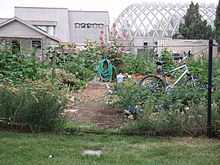
Community gardening in the United States encompasses a wide variety of approaches. Some influential community gardens, such as the Clinton Community Garden in the middle of Manhattan in New York City, and the Peralta garden in Berkeley, California, inspired by architect and community garden visionary Karl Linn, are gathering places for neighbors and showcases for art and ecological awareness, with food production cherished but seen as one part of a much larger vision. Other gardens resemble European "allotment" gardens, with plots where individuals and families can grow vegetables and flowers, including a number (for instance, in Minneapolis and Ann Arbor, Michigan) which began as "Victory Gardens" during World War II. Even such "food" gardens can be very different — for instance, plot sizes range widely from as small as 1.5m × 1.5m (5 ft × 5 ft) in some inner city gardens and art gardens, such as the Dovetail Garden in Charlotte, North Carolina, to relatively large plots of 15m × 15m (50 ft × 50 ft) such as those at Hilton Head, South Carolina.
Some community gardens, in contrast, are devoted entirely to creating ecological green space or habitat, still others to growing flowers, and others to education or providing access to gardening to those who otherwise could not have a garden, such as the elderly, recent immigrants or the homeless — for example, the Community Garden for the Homeless, in Charlotte, is not far away from the very different Dovetail Garden. Some gardens are worked as community farms with no individual plots at all, shading into becoming urban farms.
Overview
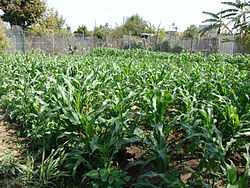
A community garden is any piece of land gardened by a group of people.[1] The majority of gardens in community gardening programs are collections of individual garden plots, frequently between 3m × 3m (10'×10') and 6m × 6m (20'×20'). This holds true whether they are sponsored by public agencies, city departments, large non-profits, or (most commonly) a coalition of different entities and groups.
Whether the garden is run as a co-op by the gardeners themselves (common in New York, Boston and other East Coast cities) or managed by a public or non-profit agency, plot holders typically are asked to pay a modest fee each year and to abide by a set of rules. Many gardens encourage activities such as work days, fundraisers, and social gatherings. Community garden organizers typically say that "growing community" is as important as growing vegetables; or, as the American Community Gardening Association (ACGA) puts it: "In community gardening, 'community' comes first." In New Orleans, community gardens have been an effective approach to cleaning up and maintaining abandoned, vacant lots.
Equally important, according to ACGA, is encouraging political involvement. As storied New York community gardener Adam Honigman puts it: "Community gardening is 50% gardening and 100% local political organizing." Community gardens are more than a meeting ground — they are also a training ground for political empowerment. In a sense, as Karl Linn pointed out, they are the 21st Century version of the New England village green, common space that brings people together and inspires shared action.
ACGA, a non-profit coalition founded in 1979, is the primary advocacy group for community gardening in the US and Canada. After many years of being hosted by the community garden support program Philadelphia Green in Philadelphia, Pennsylvania, ACGA is now based at the Franklin Park Conservatory in Columbus, Ohio.
Community gardening exists across northern North America, and is particularly strong in the Northeast, where literally thousands of community gardens grow in New York City, Philadelphia and Boston. It is also strong along the West Coast, especially in British Columbia, and in Midwestern centers such as Chicago and Minneapolis.
The European history of community gardening in the US dates back to the early 18th century, when Moravians created a community garden as part of the community of Bethabara, near modern Winston-Salem, North Carolina - a garden still active and open for visitors today. First Nations peoples also gardened with a community approach (Buffalo Bird Woman's Garden paints a picture of gardens among the Hidatsa), likely for generations before the arrival of waves of immigrants.
Academic study of American community gardening by T.J. Bassett and more recently Laura Lawson ("City Bountiful") suggests that the community gardening "movement" is best described as a series of distinct phases each with contrasting ideologies and purposes, even though all resulted in people creating gardens on public or abandoned land. The latest phase began with the alternative politics and culture and dawning ecological activism of the late 1960s.
From the mid-1970s through the early 1990s, community gardening in a select number of major American cities enjoyed Federal financial support, though many programs struggled to find funding. The loss of the Federal program increased the challenge of finding funding to support programs. Funding remains a key challenge, along with secure land tenure for garden sites, finding insurance, and helping gardeners develop ways to work together smoothly.
Community gardening in the United States overlaps to some extent with the related but distinct movement to encourage local food production, local farmers' markets and community supported agriculture farms (CSAs). Leases and rules prevent some, though not all, community gardeners from selling their produce commercially, although their gardens may donate fresh fruits and vegetables to local food pantries, cooperatives, and homeless members of their community.
However, community gardens offer ideal sites for local farmers markets, and gardeners often seek farmers to provide space-intensive crops such as corn or potatoes. They also can hire farmers to provide services such as plowing and providing mulch and manure. In turn, small farmers can reach a wider audience and consumer base by drawing on community gardeners and their contacts. Although the two approaches are distinct, both can be effective ways to produce local food in urban areas, safeguard green space, and contribute to food security. Community gardens also increase environmental aesthetics, promote neighborhood attachement and social involvement.[2][3][4]
In an interesting variant on the practice of reclaiming bombed-out areas for community gardens (also practiced during WWII in the ghettos of Eastern Europe), in American inner-cities, community groups have reclaimed abandoned or vacant lots for garden plots. In these cases, groups have subsequently leased from a municipality that claims the property or claimed squatter's rights or a right to subsistence not currently recognized by the legal system. Two notable cases include the gardens of Manhattan's lower Eastside and the South Central Farm of Los Angeles, California. A lasting legacy of the New York gardens is 'guerrilla gardening', perfected by NYC's legendary "Green Guerrillas", founded by Liz Christy. In contrast, The South Central Farm was recently bulldozed in Los Angeles.[5]
ACGA provides resources to assist anyone wishing to start a community garden or find a garden near their home, as well as training classes in community gardening organizing and management. They also offer a website, a newsletter, an email listserve and a magazine. ACGA's most recent survey suggests that the total number of community gardens around the US alone is over 5000.
Community gardens often face pressure due to economic development, rising land values, and decreased city government budgets. In some cases they have responded to the changes by forming nonprofit organizations to provide assistance and by building gardens on city park spaces and school yards.[6][7]
Impact on health
The U.S. Department of Health and Human Services recommends eating more dark green vegetables, orange vegetables, legumes, and fruits; eating less refined grains, fat, and calories; and obtaining 60 minutes of physical activity on most days.[8] Recent public health evaluations show community gardens as a promising approach to promote healthy behaviors.[3][9] This is particularly important in establishing healthy behaviors among children given the rise of childhood obesity. One recent pilot study in Los Angeles showed a gardening and nutrition intervention improved dietary intake in children and reduced body mass index.[10]
By state
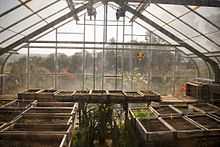
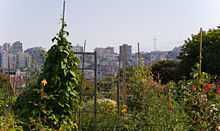
California
- San Francisco, California
In San Francisco, community gardens are available through various public and private entities. Most community gardens in San Francisco are available through its Recreation and Park Department, which manages over 35 community gardens on City property. These are allotment gardens whereby individuals or groups volunteer to be assigned garden plots. Garden members within their respective gardens democratically organize themselves to set bylaws that are consistent with City policy. These gardeners often self-impose garden dues as a membership requirement to cover common expenses. To standardize the development and management of its community gardens, the Recreation and Park Commission adopted its Community Garden Policy in 2006.
Though not plot-based, the City's Department of Public Works supports communal-style gardening on City property whereby community groups participate in the development and maintenance of public gardens. No one person is responsible for any portion of the site. One group, a community-based and resident-led volunteer group in an underserved neighborhood called Bayview Hunters Point, has created an enclosed food-producing garden on City-owned land, as well as developed many residential urban farms around privately owned homes. This group, the Quesada Gardens Initiative, is one of many organizations in the San Francisco Bay Area working at the nexus of environmental justice, health and wellness and food security, and community-building.
All of the community gardens of San Francisco are listed on the San Francisco Garden Resource Organization[11] web site with detailed directions and garden pictures of some of the gardens.
Colorado
- Denver, Colorado
There are over 100 community gardens in the Denver metro area. Gardens are located on vacant land (42%), school grounds (26%), housing facilities (15%), and other location (17%) such as churches and senior centers. Based on land tenure, community gardens in Denver are found on public land (52%), private land (24%), or owned by non-profits (16%) and Denver Urban Gardens (8%).[12] Denver Urban Gardens (DUG), a non-profit organization that assists community members with the design, planning, and construction of neighborhood community gardens.[13][14] The majority of DUG's community gardens are located in low-to-moderate income areas,[15] and more than 20 are located at Denver public schools.[16] DUG also partners with government and other non-profit agencies to offer gardening and nutrition education.[17]
Professor Jill Litt and colleagues at University of Colorado School of Public Health evaluated the effects on community gardening in the Denver metro area on social environment, community building, and fruit and vegetable intake. Community gardeners were more likely than home gardeners and non-gardeners to meet the national recommendations of fruit and vegetable intake.[2] Social involvement and neighborhood aesthetics were both positively correlated with fruit and vegetable consumption.[2] Semistructured interviews carried out by Teig and colleagues among community gardeners in Denver also revealed that gardeners felt a high level of trust between members of the garden and a strong sense of community.[18] Furthermore, gardeners were involved in community voluntary efforts and donated surplus produce to populations without access to fresh produce.
Indiana
- Jasper County, Indiana
Jasper County Indiana supports a local community garden run by local churches. The garden has given away over half a million pounds of produce to local food shelves since it was founded in 2008.[19]
Kentucky
- Frankfort, Kentucky
Commonwealth Gardens is a 501(c)3 organization dedicated to the formation of community gardens and school gardens in the Frankfort and Franklin County area. Commonwealth Gardens also encourages the consumption of locally grown food not only because it tastes better and takes less energy to produce, but also because it is important to support our local farmers and merchants.
Commonwealth Gardens has the support of the Frankfort Department for Parks, Recreation, and Historic Sites, Kentucky Employees Credit Union, Franklin County Cooperative Extension, Pioneering Healthy Communities, The Kentucky Coffeetree Cafe, Earth Tools, Inside Out Design, and many other local businesses and organizations in the Frankfort area.
Massachusetts
- Boston, Massachusetts
In the city of Boston, Massachusetts there are a variety of local and non-profit organizations which own, promote and manage approximately 180 community gardens throughout the city. These organizations include the Boston Natural Areas Network (BNAN), Boston Nature Center of the Massachusetts Audubon Society, Boston Parks and Recreation Department, Boston Urban Gardeners (BUG), MA Department of Conservation and Recreation, Dorchester Gardenlands Preserve, ReVision House, and the South End Lower Roxbury Open Space Land Trust. In 2002, the volunteer-run Boston Community Garden Council was formed as a means of facilitating communication and cooperation between these organizations along with individual gardeners in Boston.[20]
Michigan
Community gardens located in Detroit include the Earthworks Farm,[21] the North Cass Community Garden,[22] and the Woodbridge Community Garden.[23]
New Jersey
Community gardens in New Jersey include the South Orange Community Garden.[24]
New York
In New York City, community gardens include the Floyd Bennett Garden Association in Floyd Bennett Field, Brooklyn (www.FBGA.net); the Tremont Community Garden, Bronx; and the Petit Versailles garden on East Houston Street.[25] The Esperanza Garden on East Seventh Street was razed in 2000.[26] The Museum of Reclaimed Urban Space in the East Village offers guided walking tours of the neighborhood's community gardens, which number 39.[27] Begun in 1978 and still flourishing today, the Clinton Community Garden on W. 48th St. in Manhattan, became the first community garden in NYC to be transferred to permanent parkland status. [28]
Utah
- Salt Lake City, Utah
In Salt Lake City, community gardens are available through the non-profit organization Wasatch Community Gardens. On May 16, 2009[29] Wasatch Community Gardens, in collaborated with The Redevelopment Agency of Salt Lake City (RAD), launched the first People's Portable Garden in Salt Lake City. The garden is designed to stimulate growth and revitalize different areas of the city. Salt Lake City put $48,000 into the People’s Portable Garden on 900 South.[30] The People's Portable Garden is located at 900 S 200 W, Salt Lake City[31]
Washington state
- Seattle, Washington
The Seattle P-Patch program for community garden plots began in the early 70s during an economic downturn known locally as the "Boeing Bust" which had resulted in many people without work or money. Darlyn Rundberg Del Boca, a University of Washington student, saw an opportunity to promote children's gardening with a focus on growing for the local Neighbors in Need food bank program, and with the help of a Seattle Councilmember obtained permission to use part of the Picardo family's truck garden in northeast Seattle with the City of Seattle renting the land for the cost of its real estate taxes. The first garden consisted of a large central garden plot planted by children from the nearby elementary school and their parents; families who volunteered to help were offered smaller individual plots around the perimeter of the central plot. The City subsequently purchased the Picardo farm, and the program of renting individual garden plots arising from the first efforts was named 'P-Patch' in honor of the Picardo family's contribution. The P-Patch program continued to grow and currently consists of 1900 plots in 68 locations with a total of 23 acres (93,000 m2) of land, with additions planned each year, and the tradition of growing for local food banks resulted in 12.3 tons of food donated in 2008.[32]
- Olympia, WA
In 2010 the city of Olympia adopted a plan to create up to six community gardens. Currently the city has two gardens: one at Sunrise park and the Yauger Community Garden Project. There are also many private community gardens such Wendell Berry in the Bigelow neighborhood.[33]
Image gallery
-
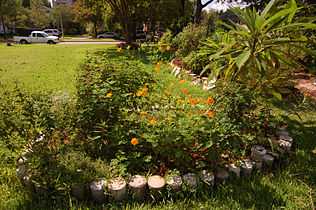
Meredith Gardens, Houston TX, 2005
-

Peralta estate, Fruitvale, Oakland, California, 2007
-

Oliver Garden, Baltimore, MD, 2008
-
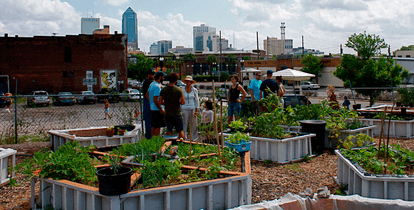
Springfield Community Garden, Jacksonville, Florida, 2008
-
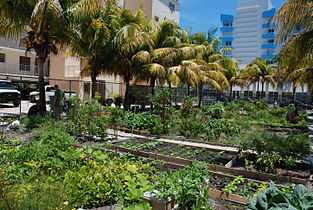
South Beach community garden, Miami, Florida, 2009
-
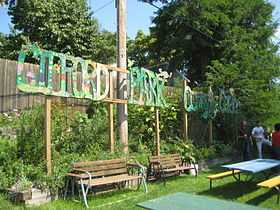
Gifford Park community garden, Omaha, Nebraska, 2009
-
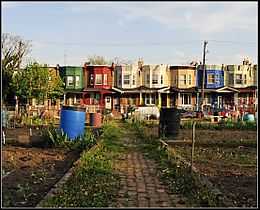
Glenwood Green Acres 18th Street & Glenwood Avenue, North Central Philadelphia, 2009
-
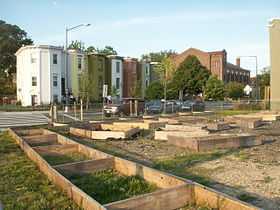
Fort Dupont Community Garden, Washington DC, 2010
-
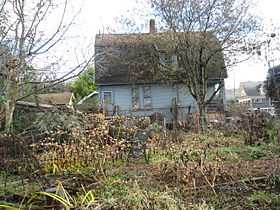
Portland, Oregon, 2010
-

Oakhurst Community Garden, Atlanta GA, 2010
-

Wise Words Community Garden in Mid-City, New Orleans, 2010
-
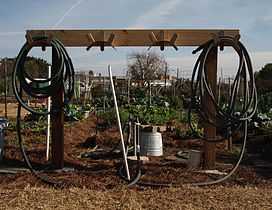
Austin, Texas, 2010
See also
- Allotment gardens
- American Community Gardening Association
- Communal garden
- Community Food Security Coalition
- Community Supported Agriculture
- Commons
- Garden sharing
- Guerrilla gardening
- Heirloom plant
- Intercultural Garden
- Seedbank
- Seed swap
- Urban gardening
- Urban horticulture
References
- ↑ American Community Gardening Association. Website: http://www.communitygarden.org/learn
- ↑ 2.0 2.1 2.2 Litt et al 2011. The Influence of Social Involvement, Neighborhood Aesthetics, and Community Garden Participation on Fruit and Vegetable Consumption. PMID 21680931
- ↑ 3.0 3.1 McCormack et al 2010. Review of the Nutritional Implications of Farmers’ Markets and Community Gardens: A Call for Evaluation and Research Efforts PMID 20184990
- ↑ Robinson-O'Brien et al 2009. Impact of Garden-Based Youth Nutrition Intervention Programs: A Review PMID 19167954
- ↑ LA's South Central Farm Shut Down and Bulldozed : TreeHugger
- ↑ Hess, David J. (2009). Localist Movements in a Global Economy: Sustainability, Justice, and Urban Development in the United States. Cambridge, MA: MIT Press. ISBN 978-0-262-01264-5.
- ↑ Hess, David J. "Case Studies of Community Gardens". Retrieved 22 July 2012.
- ↑ US Dept of Health and Human Services 6th ed. 2005
- ↑ Alaimo et al 2008. Fruit and Vegetable Intake among Urban Community Gardeners PMID 18314085
- ↑ Davis et al. 2011. LA Sprouts: A gardening, nutrition, and cooking intervention for Latino youth improves diet and Reduces Obesity. PMID 21802571
- ↑ SFGRO Home Page
- ↑ http://webmedia.unmc.edu/community/citymatch/EMCH/101807/Gardens%20and%20Health_092607.pdf
- ↑ http://dug.org/storage/DUGs%20Role%20in%20Your%20Community%20Garden.pdf
- ↑ Food gardens a growing trend - The Denver Post
- ↑ http://dug.org/storage/2008%20audit%20report.pdf
- ↑ Denver Urban Gardens - Education
- ↑ Arias, Richard. "Case Studies of Community Gardens: Denver Urban Gardnes". www.davidjhes.org. Retrieved 22 July 2012.
- ↑ Teig et al 2009. Collective efficacy in Denver, Colorado: Strengthening neighborhoods and health through community gardens. PMID 19577947
- ↑ Allen, John. "KV community Garden". KV Community Garden. Retrieved October 8, 2014.
- ↑ Dowty, Rachel. "Case Studies of Community Gardens: Boston Community Gardens". www.davidjhess.org. Retrieved 22 July 2012.
- ↑ http://www.cskdetroit.org/EWG/index.cfm Retrieved 2011-02-27
- ↑ http://www.flickr.com/photos/64429486@N00/5087725908/ Retrieved 2011-02-27
- ↑ http://www.flickr.com/photos/vanessamiller/4674707561/ Retrieved 2011-02-27
- ↑ Theresa Burns. Garden State: Building Community and a Garden. New York Times, April 22, 2010.
- ↑ Find Your Community Garden : NYC Parks GreenThumb
- ↑ Colin Moynihan. New Rules Worry Community Garden Advocates. New York Times, July 6, 2010
- ↑ The Local East Village
- ↑ http://clintongarden.org/
- ↑ Salt Lake City Government announces Portable People's Garden
- ↑ Salt Lake City News - News Articles: Public Nuisance
- ↑ Wasatch Community Gardens "New People's Portable Gardens"
- ↑ Hess, David J. "Case Studies of Community Gardens: Seattle's P Patches". www.davidjhess.org. Retrieved 22 July 2012.
- ↑ Blogger: Aanmelden
Further reading
- Sam Bass Warner. To Dwell Is to Garden: A History of Boston's Community Gardens. Boston : Northeastern University Press, 1987.
- Cindy Rosenthal. The "Common Green/Common Ground" Performance Project: The Personal, the Political, the Gardens, and NYU. TDR Vol. 46, No. 3 (Autumn, 2002), pp. 132–164
- Christopher M. Smith, Hilda E. Kurtz. Community Gardens and Politics of Scale in New York City. Geographical Review, Vol. 93, No. 2 (Apr., 2003), pp. 193–212
- "New York success story: growing the Garden of Eden in Brooklyn", Guardian Cities (Guardian.com), 20 May 2014
- "Meet the Tenacious Gardeners Putting Down Roots in 'America's Most Desperate Town'", Yes, June 9, 2014 (about Camden, NJ)
- Joseph Howard, various. Community Garden Leadership Course (Powerpoint). 2015 https://marinetteboat.com/images/GardenLeadershipv62015.pdf
External links
| Wikimedia Commons has media related to Community gardens in the United States. |
- WorldCat. Works related to community gardens in the USA
- List of San Francisco Community Gardens. List maintained by the San Francisco Garden Resource Organization.
- Flickr. 61st St Community Garden, Chicago.
- Flickr. Photos of Meg Perry Community Garden Project, New Orleans, Louisiana
- New York City Community Garden Coalition
- Urban Harvest Community Gardens, Texas
- Flickr. Photos of Barton Community Garden, Arlington County, Virginia
- Resource links compiled by the American Community Gardening Association
- Resource links related to community gardening. Published by Brooklyn Botanic Garden